
May 24, 2009
 CR Sunday Interview: Jim Ottaviani
CR Sunday Interview: Jim Ottaviani


*****
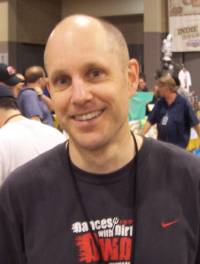
I've known
Jim Ottaviani for more than a decade now, first as an irregular but valuable writer on the
Comics Journal call-sheet and then as a writer out there on his own making comics in a series of science-related graphic novels under the
GT Labs umbrella. He has in the last ten years built an impressive resume, including books such as
Two-Fisted Science,
Fallout,
Dignifying Science,
Suspended In Language,
Bone Sharps, Cowboys, and Thunder Lizards and
Wire Mothers. Along the way he's worked with any number of skilled artists; their work and his own has been generally well-received.
In his latest effort,
T-Minus: The Race To The Moon, Ottaviani with
Big Time Attic's
Zander Cannon and
Kevin Cannon created a story about the space race mostly but not entirely from the engineers' point of view. It's a young-adult book from
Simon & Schuster's Aladdin imprint. As someone fascinated by how a giant project like this one transforms from papers being moved around on desks by doughy guys in white, collared shirts to several tons of steel being fired through the atmosphere with fighter pilots in pressure suits strapped on top, I fairly lapped it up despite almost no interest in the poetry and ideals of space programs. Ottaviani was nice enough to talk to me about this new work. -- Tom Spurgeon
*****
TOM SPURGEON: Jim, just to catch up, what's the status of GT Labs? This obviously seems more like a book packaging project than the kind of self-published, stand-alone book by which you made your name. Is there any significance to this sort of project in terms of how you might want to move forward? Are things right now where you like them?
JIM OTTAVIANI: I don't know that it has special significance, other than this is a book I was ready to do myself and publish via GT Labs. When the opportunity came along to do it with Simon & Schuster, I thought it would be an interesting experiment to see how it would work in that context. And you're right about it being a packaging situation -- I can't recall the exact sequence of events, but it was something like this: My agent asked me for a story to pitch, I gave him a proposal for what became
T-Minus, he liked it and asked who I'd like to work with on it, I said Big Time Attic, and he was able to sell it rather easily by saying something like "Here's
Bone Sharps, Cowboys, and Thunder Lizards. Give these three guys a contract and they can deliver a complete book, cover-to-cover, that you can send straight to the printer." It wasn't as easy as that -- it never is, either in the contract stage or the making-the-book stage -- but that's pretty close.
As for GT Labs, I'm working on some stories now that may find homes elsewhere, but if they don't, they have a home right here. The past few years have been consumed by doing work for other publishers, though, so the main activity I've done with my own publishing operation is keeping titles in print and selling -- I'm going back to press with three titles this spring -- and staying on readers' radars.
I wish I had a new book coming out from GT Labs soon, though. It seems like it's taking me longer than usual to get going at full speed on the two projects that I'm working on right now. So in that sense things are not where I'd like them to be. But I've learned I can't force anything to happen faster than it does, so I work at my best speed.
SPURGEON: You're right around the age where it'd hard to know if you have memories of the moon landing. Do you? In a more general sense, did you have an interest in space flight growing up?
OTTAVIANI: My folks imposed a very early bed time on me and my siblings -- I've certainly rebelled against that in adulthood! -- so as a five-year-old it was a shock to be gotten up out of bed and told I should watch TV. But two people were about to walk on the moon and they did just that. So yeah, I saw that first landing live, built the Revell model kits of Eagle and Columbia, and have had space on my brain ever since. The interest has waxed and waned over the years, but it's always been there. Kat and I tried to get out to see the ITS-119 launch this February, in fact. Some pesky valve ruined those plans, but we still spent two days at the
Kennedy Space Center.
SPURGEON: What was the specific genesis of this project? At what point did the idea come together in your head in a way that resembles the book it became?
OTTAVIANI: I knew I'd do something about the space race eventually, so the specific genesis was the one I described above: I got asked for a pitch and I dipped into the list of stories I wanted to do someday and moved this one to the head of the queue. Featuring the engineers and scientists and the Russians was always part of my plan, so in that sense the basic spine of the story you read was there from the start.
SPURGEON: Was it always meant to be aimed towards younger readers? Because it seems like you've targeted that kind of audience. Did that make any difference in the writing?
OTTAVIANI: Yes, the young adult audience was our target audience because that's what Simon & Schuster wanted. That said, Zander, Kevin, and I agreed early on that we were going to require them to bring their A-game to the book. No dumbing down, nothing as simplistic as "Rah Rah Go Astronauts YAY," or any of that sort of thing, since we wanted it to appeal to adult readers as well. Zander put it well when he said he always preferred adult-oriented but kid-accessible books when he was in his early teens, and I realized I did, too. So that's the type of book we tried to create.
It did make a difference in the writing, in that there are things you just can't say or show in books targeted at that audience. Nobody can smoke, for instance. In reality, lots of people smoked in Mission Control. Heck, lots of astronauts smoked. But that sort of detail is one you just let go -- it's not that important.
As far as the story itself is concerned, there are more kids in it than a story about the space race might usually have. But having characters for the readers to relate to, and see themselves in -- if only to get the wonder of the age -- was something Liesa Abrams, our editor, emphasized. So I dug deeper for authentic stories that fit into the narrative arc we wanted. And they're out there, so I found them and it worked out well.
 SPURGEON: You're working again with the Big Time Attic gang, as you mentioned. What led you to believe their strengths would lend themselves to this project? What did you learn about working with them on
SPURGEON: You're working again with the Big Time Attic gang, as you mentioned. What led you to believe their strengths would lend themselves to this project? What did you learn about working with them on Bone Sharps
that might have made for a betting working relationship this time around?
OTTAVIANI: Their strengths are many, but the important ones here were that they can draw anything, they don't blow stuff off just because it might be hard to depict, they're willing and able to do the visual research when I didn't give them everything they needed, they're smart and can catch and correct errors I might have made, they always serve the story, and they're realistic about deadlines.
Those are all things I learned via the
Bone Sharps experience, since I only had a gut feeling about them being good before going into that earlier project. It was a feeling based on knowing Zander as a friend and professional. I figured that if he was going to set up a studio, he would do it right, with the right people. And that turned out to be true.
SPURGEON: For that matter, how do you work with those guys in terms of the script you provide and the nuts and bolts of it? Are you a full script writer? Do you design the pages as well?
OTTAVIANI: Yes, I write full script, and it's funny you should ask about page design. Usually, I'll draw out the entire book in stick figure form and send those rougher-than-rough roughs to artists in case they want to refer to them. There wasn't time for that with this book, but I did send layouts in terms of how panels should be arranged for some of the trickier scenes so Zander and Kevin would know what I was after. As you saw, some of those would have been complicated to describe, but a quick sketch showing the panel arrangements I had in mind made things clear.
Our travel schedules worked out well during production, so Zander and I met up in Minneapolis, New York, and San Diego and went through sketches, thumbnails, and penciled pages together, in person, and that helped improve things. He was able to talk me out of some strongly held ideas I had about the way a few sequences should look by showing me that what he and Kevin had worked out was better, and why.
 SPURGEON: The most dramatic design element in
SPURGEON: The most dramatic design element in T-Minus
is found in these kind of diagrammatic representations of space missions that you place in the left and sometimes also the right hand margins. I'll try to find a page where the readers can see that basic design structure with the columns containing rockets in them outside of the comics narrative. Can you talk about where those came from and how you hope they work?
OTTAVIANI: Necessity. There were a lot of missions, all which which were important steps towards getting to the moon, and we didn't want to ignore any of them. There were also a lot of failures, especially early on.
The way I called these out in the script was as "marginals," as in the
Sergio Aragones bits that scramble around the page edges of
MAD. What we did was entirely unlike that crazy and funny stuff he does, but with the same notion of them being there as extra bits for readers that contribute to the book but don't often directly contribute to the main narrative. There were a couple of places where we blurred the story/marginal line on purpose, but for the most part they frame the action and provide time signals.
 SPURGEON: How about the change in lettering styles for the Russian view of things? Whose idea was that, and what did you hope to accomplish with that flourish? Was it just a signifier to help the reader keep track of changes in location?
SPURGEON: How about the change in lettering styles for the Russian view of things? Whose idea was that, and what did you hope to accomplish with that flourish? Was it just a signifier to help the reader keep track of changes in location?
OTTAVIANI: That was my idea, but the excellence of the final implementation is of course Kevin's doing. I initially wanted something even stronger -- think
[Ken] Bruzenak's work in American Flagg! -- but there were concerns from the editors about readability, so we scaled back. Again, all hail Kevin Cannon for finding the right balance.
And yes, we did it to help show a change in location, and to remind readers that significant things happened and advanced in places that were far away from the U.S. and the English-speaking world.
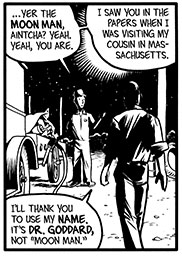 SPURGEON: In terms of the narrative, your opening is deceptively straight-forward. It seems like we're going to get the scientists' view of the race to the moon starting in 1957 with Sputnik and some other events, but then
SPURGEON: In terms of the narrative, your opening is deceptively straight-forward. It seems like we're going to get the scientists' view of the race to the moon starting in 1957 with Sputnik and some other events, but then T-Minus
goes all Billy Pilgrim with jumps around in time and location as you introduce certain players. Can you talk a bit on how you structured the first 25 pages? Why do you feel it was important to contextualize those actors and their actions with a look at their past?
OTTAVIANI: The story of the space race itself is all about context. Why try to get to space? Why the moon? Why in the 1960s? What next? And, as an implied question that we leave unanswered, why not now?
Also, were all these people geniuses who made up the technology and dreamed the dreams in 10 years? The answer to this one is no -- they worked hard, but based that work on discoveries and ideas that went a long way back. I wanted to at least hint at that work, and the international nature of the building blocks, so that's why we went all Billy Pilgrim... without Montana Wildhack, but there's that YA audience to consider so... so it goes.
Sorry, couldn't resist. I just reread
Slaughterhouse Five late last year.
SPURGEON: You also fold some characters into one another -- how difficult was that process? Were there earlier drafts with more players that you later pared down or did you settle on your version of the cast pretty quickly? What were the steps involved with doing that?
OTTAVIANI: There are only a few characters that got lost or absorbed into others between early drafts and the final. I knew from the outset that we couldn't include everybody we'd want, so the compression started before I wrote the first panel description. Still, a few engineers like
Tom Kelly of Grumman and Owen Maynard of NASA went away relatively late in the game, and it was a tearful farewell, since I liked them both.
The steps involved weren't complicated -- if there were good lines someone said or important activities they took part in, Stormy or Max or C.C. got tapped for the delivery. They were up to the task.
SPURGEON: Were there histories of the race to the moon or general histories from which you derived an approach or two? Were there any that you felt you needed to avoid replicating or recalling?
OTTAVIANI: You know, I don't think there were any specific histories from which I took what might appear a novel approach. Most of the books I read are straight-ahead stories about what happened, and outside of
Apollo by Murray and Cox, none discuss the teams of scientists and engineers in any depth, if at all. But even in the Murray and Cox book the storytelling is straight ahead, so I only used it for facts.
One thing I consciously avoided looking at while writing the book were dramatizations, like HBO's excellent
From the Earth to the Moon. I was afraid of swiping from that, and though I'd seen it many years ago I stayed away until Kevin and Zander had finished the pencils. Having just gone back to watch it again, I didn't see anything that made me cringe and say to myself "Tom Hanks and Andy Chaikin are going to sue me for that bit." So that's good.
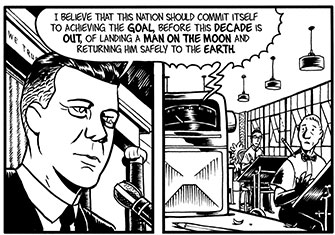 SPURGEON: One historical mention I thought was interesting very early on is that you contrast the Eisenhower Administration's lack of preparedness to process Sputnik with the Kennedy Administration's response to the first manned Soviet space flight. Yet you also showed the horrified reaction of scientists when given Kennedy's 1970 moon-landing deadline. Is there anything you generally wished to say about how politics works with scientific progress like this?
SPURGEON: One historical mention I thought was interesting very early on is that you contrast the Eisenhower Administration's lack of preparedness to process Sputnik with the Kennedy Administration's response to the first manned Soviet space flight. Yet you also showed the horrified reaction of scientists when given Kennedy's 1970 moon-landing deadline. Is there anything you generally wished to say about how politics works with scientific progress like this?
OTTAVIANI: An excellent question, and one I didn't think about consciously while writing the book. Partly because the goal was to make it accessible to younger readers, and I'm not smart enough to figure out how to make geopolitics interesting to them. The other reason, probably, is that I think I already dealt with that in
Fallout, a book I did about
J. Robert Oppenheimer,
Leo Szilard, and
the Manhattan Project a few years ago.
But... now that you mention it, maybe there is a little bit to it. Here's 20/20 hindsight: Politicians pronounce many things, but often do so with little sense of the difference between what is currently achievable vs. technically possible vs. only dreamed about. Their speeches usually focus on the last two of those things, because that's what gets the public's interest and what gets them elected. Engineers are by nature conservative in what they promise because -- cynicism alert! -- unlike politicians, we expect them to deliver. But the rule of thumb is that engineers overestimate what they can do in one year and underestimate what they can do in ten. So if you fund them for those ten years, you'll often get something between the possible and the dreamed-about. Just keep in mind that they're usually wrong about how much things will cost.
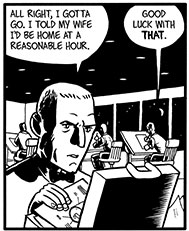 SPURGEON: There are flashes of the personal costs involved -- the fire, the resignation that follows the fire, another man imposing on his family to the point he seems to feel bad they're eating at midnight in order to share a meal with him -- what made you decide to include those elements and how conscious were you in an already crowded and complicated narrative in terms of choosing which ones to explore?
SPURGEON: There are flashes of the personal costs involved -- the fire, the resignation that follows the fire, another man imposing on his family to the point he seems to feel bad they're eating at midnight in order to share a meal with him -- what made you decide to include those elements and how conscious were you in an already crowded and complicated narrative in terms of choosing which ones to explore?
OTTAVIANI: Very conscious. Some were already there -- the space race is a story of sacrifices on both sides of the Iron Curtain, and the astronaut and cosmonaut deaths are an important part of the story. Liesa convinced me that it was just as important to show more of the less dramatic but still real costs to wives, children, friends, and the other people linked to the programs. It took some work to pick which ones, and how to integrate them smoothly into the overall narrative, but she was right and I think those moments strengthen the emotional pull of the story.
SPURGEON: While I got a clear picture on the kind of institutional resiliency and practical decision-making that put Americans on the moon, I'm not sure that I got the same sense of why the Soviet efforts failed. There are suggestions that they lost the lynchpin of the program and that they made some poor design choices, but I wondered if you had an opinion as to why they fell short.
OTTAVIANI: This is mostly opinion, but it's backed by the research I did. First, I think they failed because the whole country wasn't publicly involved in the work. Secrecy and too much compartmentalization hurt them in the end -- in an odd twist to the stereotype, the Soviet program suffered from too much internal competition regarding technology, especially once Korolev was gone. Second, they did rely too heavily on a single person to keep things going. We show Max and C.C. and Stormy and John Houbolt and a whole bunch of other engineers making decisions and debating approaches on the U.S. side. On the Soviet side we show Korolev, and that's about it. Not entirely fair, but not wholly inaccurate. Third, and partly as a result of the previous two factors, the Soviet technology didn't end up being up to snuff. We depict the quality control problems they had, and their lack of computing ability in the book, and those were a big deal.
The book suggests all of these things, but doesn't state them outright. Maybe that was a mistake, but I didn't want to lead readers to believe that it's just one thing that caused the Soviets to fail and the U.S. to succeed. And I just as much wanted to show that their designers were good, their cosmonauts were brave and skilled, and that this really was a race. The U.S. won it, but it wasn't a foregone conclusion, and nobody knew if it was even winnable until very late in the decade.
 SPURGEON: How careful were you in trying to find the humorous moments? There's a great scene where American astronauts are about to leave the orbit of earth and Michael Collins laughs at the sheer lack of poetry in what they're calling it. How did you decide what stories of that kind to tell and what not to? What appealed to you about that specific moment?
SPURGEON: How careful were you in trying to find the humorous moments? There's a great scene where American astronauts are about to leave the orbit of earth and Michael Collins laughs at the sheer lack of poetry in what they're calling it. How did you decide what stories of that kind to tell and what not to? What appealed to you about that specific moment?
OTTAVIANI: That specific moment was in the very first draft. Michael Collins' book
Carrying The Fire is the best astronaut autobiography or biography I've read. Hands down and nothing even comes close; he's a good and thoughtful writer. I'm going to quote from his remarks to Congress now, just as a sample so everybody will go read his book:
"Many years before there was a space program my father had a favorite quotation: 'He who would bring back the wealth of the Indies must take the wealth of the Indies with him.' This we have done. We have taken to the moon the wealth of this nation, the vision of its political leaders, the intelligence of its scientists, the dedication of its engineers, the careful craftsmanship of its workers and the enthusiastic support of its people. We have brought back rocks and I think it's a fair trade...
"During the flight of Apollo 11, in the constant sunlight between the earth and the moon, it was necessary for us to control the temperature of our space craft by a slow rotation not unlike that of a chicken on a barbeque spit. As we turned, the earth and the moon alternately appeared in our windows. We had our choice. We could look toward the moon, toward Mars, toward our future in space -- toward the new Indies -- or we could look back toward the earth, our home, with its problems spawned over more than a millennium of human occupancy.
"We looked both ways. We saw both, and I think that is what our nation must do."
If you've seen him in movies like
In The Shadow Of The Moon, you know he's a great interviewee as well. So anyway, that bit from the Apollo 8 mission is essential to the book. It speaks to the wonder of what we're doing, to the inner life that these outwardly cool test pilot/astronauts lived, and yeah, it's funny. Zander and Kevin nailed it visually, too.
Overall, I wanted the humorous bits not to just be funny for their own sake, but to show how these people broke the tension of what was a prolonged period of hard work and stress. It makes them human, especially the astronauts, who people tend to think of as icons. That the best known pictures of them make them all look alike -- I mean, if you've seen one guy in a spacesuit you've seen 'em all -- contributes to that, so showing that there were people inside, people who made jokes even while they're sitting on top of a tons of burning rocket fuel or dealing with alarms or landing on the moon makes them real.
SPURGEON: I wanted to ask about a couple of specific pages. Whose decision was it to make Page 100 a single image? Why did you want that image to hit with the strength that a full-page might in the context of all those visually complex pages?
OTTAVIANI: That was my decision, and was planned from the start. I'm going to try not to give too much away here -- just as you didn't, so thanks for that! -- so I'll leave it at this: You'll notice the contrast between that and the imagery we chose for the next mission we depict. No single-page images, nothing you'd recognize from a photograph, etc. I'm grateful that Liesa didn't push hard for, much less demand, the obvious choices in that second situation. The reason I wanted it that way was because to me, page 100 is the most important image we'll ever get from space.
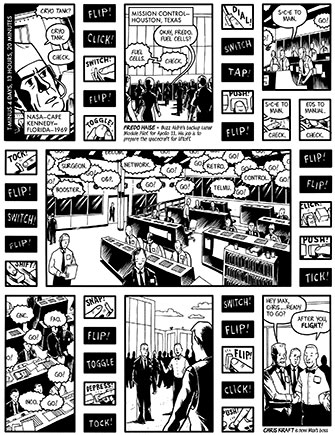 SPURGEON: The other page I really liked near the end of the book was page 110, with all the flips and toggles. It was a fun page, but it seemed to me to also signify how complex the process was and how much more efficient the American side of things had become. Is that close to what you might have been trying?
SPURGEON: The other page I really liked near the end of the book was page 110, with all the flips and toggles. It was a fun page, but it seemed to me to also signify how complex the process was and how much more efficient the American side of things had become. Is that close to what you might have been trying?
OTTAVIANI: Um...yeah. I can't really add to what you just said. It's what we were aiming for, and I'm glad you agree that Kevin and Zander achieved the goal. Can you tell I have a serious writer-crush on their artwork? If you told me I could only ever work with them for the rest of my career, I wouldn't mind at all. Well, maybe a little, but not nearly as much as you might think.
If you told them that they'd probably slit their wrists, though.
 SPURGEON: I liked a panel where we see I think Alexei Leonov watching the Christmas Day lunar orbit mission with a smile on his face. It reminded me of an earlier sequence where two Soviets were laughing at the John Glenn rescue mission and the higher-up kind of suggests that this is a perfectly reasonable thing and not funny at all. Did the astronauts and mission specialists and designers have sympathy towards what the other team was trying?
SPURGEON: I liked a panel where we see I think Alexei Leonov watching the Christmas Day lunar orbit mission with a smile on his face. It reminded me of an earlier sequence where two Soviets were laughing at the John Glenn rescue mission and the higher-up kind of suggests that this is a perfectly reasonable thing and not funny at all. Did the astronauts and mission specialists and designers have sympathy towards what the other team was trying?
OTTAVIANI: That's an interesting connection to have made. It wasn't intentional, but is one of those happy accidents that my subconscious guided. Or maybe it's just a happy accident full stop. Either way, at the astronaut/cosmonaut and engineer/engineer level, there was respect and camaraderie. These folks did occasionally meet at professional conferences, or in the case of astronauts on goodwill tours, and they talked more freely about their work than you might imagine. There were still secrets, and rivalry, but they were soldiers in the trenches, so to speak, and they enjoyed talking to their peers and wanted to learn what they could from each other and share what they could as well.
 SPURGEON: One scene that I found slightly confusing in retrospect was the lunar mode decision conference. Why did you spend so much time there? What would you have us take away from that particular -- and entertaining -- back and forth that made you want to spend a few pages there?
SPURGEON: One scene that I found slightly confusing in retrospect was the lunar mode decision conference. Why did you spend so much time there? What would you have us take away from that particular -- and entertaining -- back and forth that made you want to spend a few pages there?
OTTAVIANI: I'm glad it was entertaining at the time you read it, and sorry that it was slightly confusing in retrospect. The conference is there, in detail, because that was the turning point of the moon landing program, and it was an example of many minds getting together and hammering out a solution to the fundamental problem of how you get to the moon
and get back. That was Kennedy's challenge, after all:
"[T]his nation should commit itself to achieving the goal, before this decade is out, of landing a man on the moon and returning him safely to the earth."
It's no good to get 'em there and leave 'em, in other words.
And so the conference brings together a number of big ideas in the book. There's the contrast between dreams and reality, where we see that landing the whole, towering, rocket on the Moon, just like you might have on the cover of a science fiction novel. This Direct Ascent mode -- there and back all in one machine -- has enormous appeal, but as pragmatic people you have to give that one up. Even if you're Wernher von Braun, you have to give it up.
Then there's the notion of what we're capable of doing today vs. what we think we can do tomorrow -- that concern is reflected in the debate that centers around Earth Orbit Rendezvous. It feels safer to do the hard stuff closer to home, and probably allowed the engineers to feel like they could control things better. But again, you have to give up some of the control to the astronauts.
Third, there's the image of one man,
John Houbolt, winning over scientists and engineers and managers with a clear conviction and the right idea: Lunar Orbit Rendezvous.
Fourth, there's the sacrifice that Storms and North American Aviation are willing to make. They know their company can't build all these things even though they want to do it, both for pride and money. But they look to the greater good in this case and make an active decision to not work purely for their own self-interest.
And finally, the idea of trade-offs and risk gets pushed through here, and how early those decisions had to get made. Crucial stuff for a moon landing had to be decided before you had any significant experience in space at all.
SPURGEON: Now that it's done, and drawn and you've likely read it with at least the beginnings of distance, what do you think distinguishes your work from others that cover the same period of time?
OTTAVIANI: Pictures! Engineers as well as astronauts! Soviets as well as the US! A suggestion that the most important event wasn't the one everybody remembers best! Pictures!
That's all tongue-in-cheek, but those really are the main distinguishing features, at least to my mind. Maybe that's because you give me too much credit; I'm a long ways away from viewing the book at a distance. I really do like the story too much, have too many things on the cutting-room floor that could make for books on their own, and I haven't yet seen the final printed copy so I'm not sure I believe it's real yet! Ask again in a year, maybe?
SPURGEON: What's next, Jim?
OTTAVIANI: Two books from
First Second, and I'm working on two other books right now. One may have only a few pictures, and is fiction, and is something I don't want to talk too much about yet.
Terra Incognita. The other is about
Alan Turing. I'm not sure if those will be GT Labs books or titles I do with different publishers. I have the inkling of the third book in my "science of the unscientific" series starting to fill up corners of my mind too. That's a ways away, though. And I have a whole bunch of proposals and pitches out there, waiting for nibbles and/or commitments.
*****
* cover from PDF
* photo of Jim Ottaviani by Whit Spurgeon, 2008
* that sharp Big Time Attic look
* what the pages with the columns devoted to launches look like design-wise -- dialogue kept obscured on purpose here
* that Russian lettering
* panel from one of the time-jumps
* Kennedy throws down the gauntlet
* the human cost of the moon project
* Michael Collins cracks himself (and me) up
* panel of question of cosmonaut with family watching US astronaut
* panel from the lunar orbiter sequence
* flip page
* a Cosmonaut landing on his feet (below)
*****
*
T-Minus: The Race To The Moon, Jim Ottaviani and Kevin Cannon and Zander Cannon, Aladdin, softcover, 128 pages, May 19 2009, $12.99.
*****
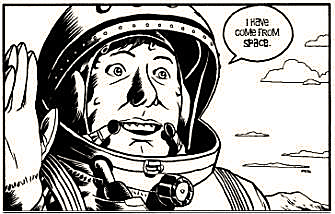
*****
*****
posted 8:00 am PST |
Permalink
Daily Blog Archives
November 2019
October 2019
September 2019
August 2019
July 2019
Full Archives


